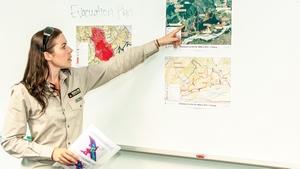Market Access and Risk Management - Impact Stories
IO5 – Protect and enhance market access and improve risk management in the forest industry including forest health and preparedness for biosecurity incursions, fire and climate change
Innovative fire behaviour tools prove their worth
 As a result of over 20 years of collaborative research
between Scion and New Zealand’s National Rural Fire Authority (NRFA),
rural fire managers have access to a range of innovative fire behaviour
tools that have been developed or adapted specifically for New Zealand
conditions.
As a result of over 20 years of collaborative research
between Scion and New Zealand’s National Rural Fire Authority (NRFA),
rural fire managers have access to a range of innovative fire behaviour
tools that have been developed or adapted specifically for New Zealand
conditions.
These were put to the test in
February by Scion fire scientist Veronica Clifford. Veronica served as
technical specialist for the National Incident Management Team deployed
to manage wildfires that swept through 600 hectares of forest at
Onamalutu, in Marlborough.
The fire destroyed
forest and farms, and threatened numerous homes and properties. It took
the efforts of 15 aircraft, 180 fire fighters plus an NRFA national
incident team to bring the fire under control, with an estimated cost of
$1.4 million.
Using the Prometheus fire
behaviour model and the New Zealand Fire Behaviour Toolkit, Veronica was
able to provide fire weather forecasts, and fire behaviour and growth
predictions for the Marlborough/Kaikoura Rural Fire Authority (MKRFA).
These predictions formed the basis of operational decisions made around
resource deployment and possible evacuations.
“By taking into account weather conditions, the lie of the land and
vegetation, and the way they interact, we can go a long way to
predicting the behaviour of most fires,” says Veronica. “I used
up-to-date weather forecasts for the area and other information to
predict what the fire was likely to do over the next 12-hour period.
Then I briefed management and the fire crews at twice daily shift
changes.”
Richard McNamara, Principal Rural
Fire Officer for the MKRFA said having Veronica on the team meant fire
crews received real time advice on a complex fire, with multiple fuel
types on rough terrain.
“We used Veronica’s
predictions to make decisions as to where to concentrate firefighters
and aerial support, and when evacuations might be necessary.
“The wind changing direction was especially concerning. When we
knew a southerly change was on its way, Veronica and I tracked its
progress closely. The fire crews were working amongst tall timber at the
time and there was a risk of weakened trees toppling when the wind
changed.”
Following a post-event review of
the fires, Veronica used Prometheus to demonstrate the likely behaviour
and magnitude of the fire without suppression, and illustrate the
“values saved” by the firefighting efforts.
Prometheus is Canadian software that has been adapted for use in
New Zealand and validated against a number of historical New Zealand
wildfires. The model can be used for a range of applications including
forecasting wildfire growth, providing post-fire support for wildfire
investigations, and planning prescribed burns. It can also be used to
conduct “what if” scenarios to support readiness and reduction planning
as part of the Strategic & Tactical Fire Management Planning
process.
In the case of the Onamalutu fire,
it was used to develop evacuation plans by identifying threatened
communities and possible egress.
The
Prometheus model was also used in a post-fire review of a wildfire that
threatened the South Canterbury township of Twizel in January. This
demonstrated the effectiveness of fire suppression efforts taken and the
values saved by comparing actual fire spread with modelled potential
fire spread. Results from this modelling have sparked interest from the
community to establish a green break around the town for future fire
protection.
“We take a hands-on approach to
fire research,” says Veronica, who is also a volunteer rural
firefighter. “We work closely with fire managers, rural fire authorities
and other research organisations to ensure the models and tools we
develop are relevant and validated by rigorous science. The results of
this collaborative research help support the critical decisions made by
rural fire managers.”
The Prometheus
adaptation project was initially funded by DOC in 2009-10, followed by a
10-day secondment by Veronica at DOC to further investigate the use of
Prometheus for strategic planning purposes.
In 2010, Scion’s Rural Fire Research Team trained DOC staff to use
Prometheus. Last year a further 46 New Zealand fire personnel were
trained in Prometheus with fire managers using it for a range of
operational and strategic planning purposes. Due to ongoing demand,
Scion will be continuing to run training and refresher courses to ensure
there are sufficient skilled operators around the country.
Collaborators / Partners: Alberta Sustainable Resources & Development; Heartland Software Solutions (Canada)
Investment: Rural fire users including DOC, NRFA, NZFS, LGNZ, NZFOA, NZ Defence Force
Short url: www.scionresearch.com/fpsciencereport2014 & www.scionresearch.com/ar15firebehaviourtools
www.scionresearch.com/fpsciencereport2014
